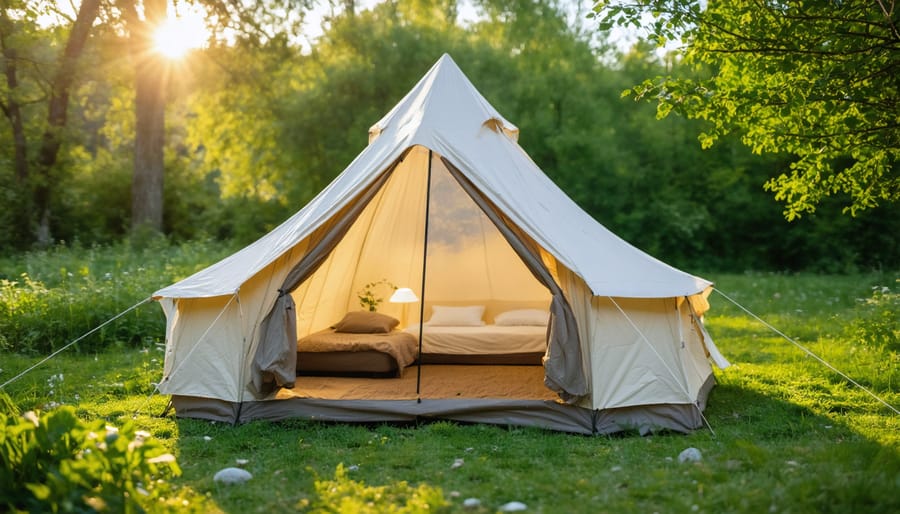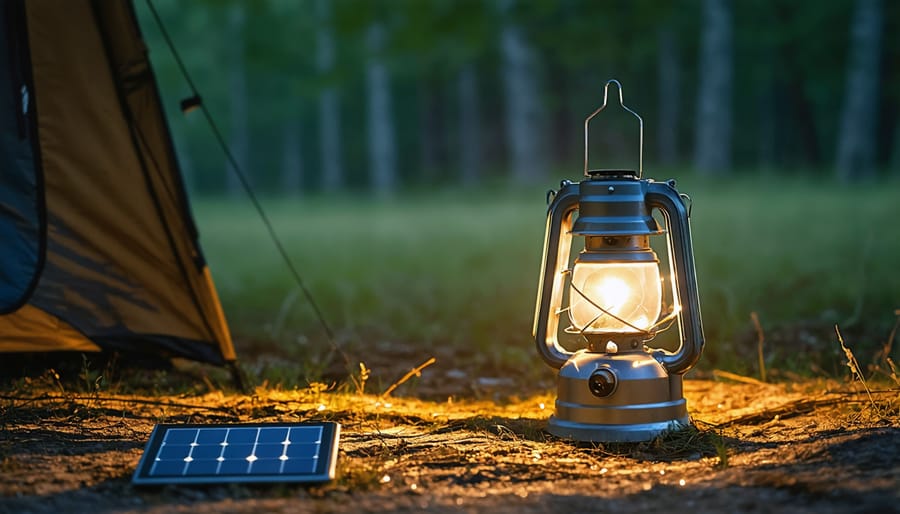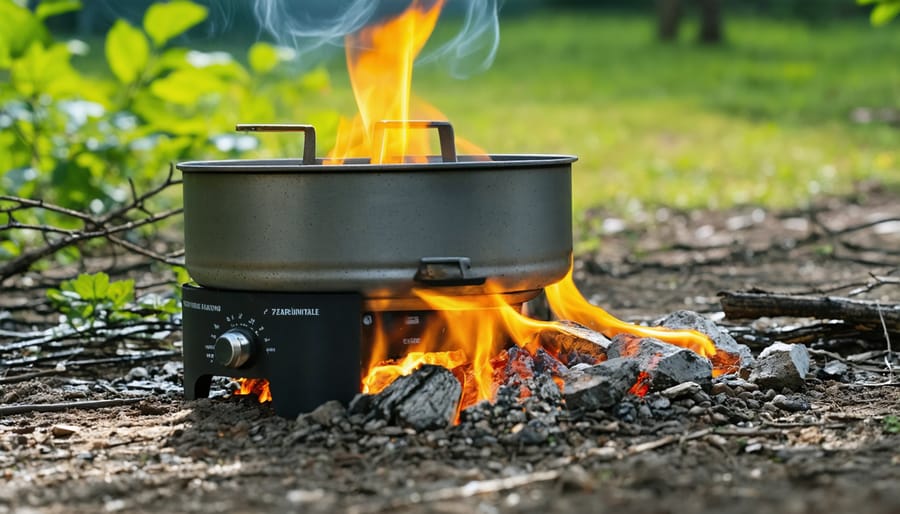Transform your outdoor adventures into earth-conscious experiences with innovative eco-friendly products designed specifically for camping. Today’s sustainable gear combines cutting-edge materials like recycled polyester, biodegradable tent stakes, and solar-powered lighting with rugged durability that withstands nature’s challenges. Gone are the days when choosing environmentally responsible camping equipment meant compromising on performance or comfort.
Modern eco-conscious camping gear delivers impressive functionality while significantly reducing your environmental footprint through innovative features like:
– Solar-powered charging systems that eliminate the need for disposable batteries
– Sleeping bags and tents made from recycled materials that maintain superior insulation
– Water filtration systems that remove the need for plastic bottles
– Biodegradable camping soap and cleaning supplies that protect local ecosystems
Whether you’re an occasional weekend camper or a seasoned backpacker, investing in sustainable outdoor gear not only supports environmental conservation but often provides superior durability and long-term value. The latest generation of eco-friendly camping equipment proves that protecting nature and enjoying it can go hand in hand, without sacrificing the reliability and comfort you need for a successful outdoor adventure.
Sustainable Sleeping Solutions
Eco-Conscious Tents
When it comes to eco-friendly outdoor living, your tent choice can make a significant environmental impact. Today’s sustainable tent manufacturers are revolutionizing the industry with innovative materials and responsible production methods.
Look for tents made from recycled polyester (rPET) fabrics, which repurpose plastic bottles into durable tent materials. These tents not only keep plastics out of landfills but also perform exceptionally well in various weather conditions. Leading brands now offer options featuring up to 70% recycled materials in their designs.
Pay attention to manufacturing processes too. Some companies use solar-powered facilities and water-saving dyeing techniques to reduce their carbon footprint. PFC-free water repellent treatments are becoming standard, offering excellent protection without harmful chemicals.
Consider tents with modular designs that allow for part replacement rather than full tent replacement when wear occurs. This approach significantly extends the tent’s lifespan and reduces waste. Many eco-conscious manufacturers also offer repair services and spare parts, encouraging users to fix rather than replace.
For maximum sustainability, look for certifications like bluesign® or Global Recycled Standard (GRS). These verify the manufacturer’s environmental claims and ensure responsible production practices. Remember, the most sustainable tent is one that lasts for years, so prioritize quality construction alongside eco-friendly materials.

Green Sleeping Bags and Pads
Getting a good night’s sleep in the great outdoors doesn’t have to come at the environment’s expense. Today’s eco-friendly sleeping bags and pads offer impressive warmth and comfort while minimizing their environmental impact through innovative materials and sustainable manufacturing processes.
Many environmentally conscious manufacturers now use recycled materials for both the outer shell and insulation of their sleeping bags. Look for bags made from recycled polyester derived from plastic bottles – some brands even tell you exactly how many bottles went into each bag. For those seeking natural alternatives, sleeping bags filled with responsibly sourced down or innovative plant-based insulation materials like kapok fiber offer excellent warmth-to-weight ratios.
When choosing an eco-friendly sleeping pad, consider options made from recycled foam or natural rubber. Some innovative companies have developed sleeping pads using bio-based foams derived from plant materials, offering the same comfort as traditional petroleum-based products with a much smaller carbon footprint. Closed-cell foam pads made from recycled materials are particularly durable and can last for many years, reducing the need for frequent replacements.
Pay attention to certifications like bluesign® or Global Recycled Standard (GRS) when shopping for sleeping gear. These indicate that the products meet strict environmental and social responsibility standards throughout their manufacturing process.
To extend the life of your eco-friendly sleeping gear:
– Store bags uncompressed in a cool, dry place
– Air out your sleeping bag and pad after each use
– Spot clean when possible to avoid unnecessary washing
– Use a sleeping bag liner to keep the main bag cleaner longer
– Repair small tears or holes promptly rather than replacing the entire item
Remember that the most sustainable option is often gear that lasts for many years, so invest in quality pieces that will withstand regular use while maintaining their performance characteristics.
Clean Energy Camp Solutions
Solar-Powered Lighting
When it comes to lighting up your campsite sustainably, solar-powered options have revolutionized the way we illuminate our outdoor adventures. These eco-friendly lighting solutions harness the sun’s energy during the day to provide reliable illumination at night, eliminating the need for disposable batteries and reducing your environmental impact.
Lanterns are the workhorses of solar camping lights, offering versatile functionality for your campsite. Look for models with multiple brightness settings and emergency backup charging capabilities. The best solar lanterns feature durable construction, water resistance, and fold-flat designs for easy packing. Many modern options include USB ports for charging small devices, making them doubly useful on extended trips.
String lights add both functionality and ambiance to your camping setup. Solar-powered LED string lights can be draped around your tent or campsite, providing gentle illumination that’s perfect for evening gatherings. Most varieties automatically turn on at dusk and include different lighting modes for various situations.
Headlamps and flashlights with integrated solar panels are excellent companions for nighttime activities. While these typically include backup battery options, their solar charging capability means you’ll rarely need to rely on disposable batteries. When choosing a solar headlamp, prioritize models with adjustable straps, multiple beam settings, and red light modes to preserve night vision.
Pro tip: To maximize the efficiency of your solar lights, position the panels in direct sunlight during the day, and clean them regularly to ensure optimal charging. Consider models with indicators showing battery level and charging status to better manage your lighting needs.
For emergency preparedness, invest in at least one solar light with a hand-crank backup charging option. This ensures you’ll have light even during extended periods of cloudy weather. Many campers find that combining different types of solar lights – perhaps a primary lantern, string lights for ambiance, and individual headlamps – creates the most versatile and reliable lighting system for their outdoor adventures.

Renewable Power Banks and Chargers
Keeping your devices charged while camping doesn’t have to come at the environment’s expense. Today’s sustainable energy solutions offer eco-conscious campers reliable power options that harness nature’s resources.
Solar-powered banks are leading the charge in green camping technology. Look for models with monocrystalline panels, which offer the highest efficiency rates and perform well even in partial shade. Many modern units come with built-in LED lights and multiple USB ports, making them perfect for charging phones, tablets, and cameras simultaneously.
When choosing a solar charger, consider the watts rating – higher numbers mean faster charging times. A 20-25W charger typically provides enough power for personal devices, while 40W+ models can handle larger equipment. Foldable designs are particularly camping-friendly, offering compact storage while maximizing solar collection surface when deployed.
Portable wind turbines are emerging as another exciting option for overnight camping. These lightweight devices can generate power day and night, complementing solar chargers perfectly. Some models even double as tent poles, saving space in your pack.
For backup power, consider hand-crank chargers. While they require some effort, they’re invaluable during extended cloudy periods or emergencies. Modern versions can generate about 20 minutes of phone time from just 5 minutes of cranking.
Maintenance tips for your eco-friendly power gear:
– Keep solar panels clean and scratch-free
– Store batteries at around 40% charge when not in use
– Protect connectors from moisture and dirt
– Test all equipment before each trip
– Position solar panels for maximum sun exposure throughout the day
Remember to check the weather forecast before your trip to plan your charging strategy. Multiple power sources provide the most reliable solution, ensuring you stay connected while minimizing your environmental impact.
Sustainable Cooking and Water Solutions
Green Cooking Equipment
When it comes to eco-friendly cooking in the great outdoors, today’s sustainable options make it easier than ever to minimize your environmental impact while preparing delicious meals. Solar-powered cookers are leading the charge in green cooking technology, offering a zero-emission way to prepare hot meals using nothing but the sun’s rays. These innovative devices fold flat for easy transport and can cook everything from soups to rice when conditions are right.
For more traditional cooking methods, look for camp stoves that run on renewable or cleaner-burning fuels. Biomass stoves that use fallen twigs and pine cones as fuel are an excellent choice, eliminating the need for disposable fuel canisters. These efficient stoves produce minimal smoke and often include built-in fans to optimize burning, making them both eco-friendly and practical.
When selecting cookware, opt for durable materials that will last for years of camping adventures. Stainless steel pots and pans, while slightly heavier than aluminum alternatives, offer superior longevity and are fully recyclable at the end of their life. Look for sets that nest together to save space in your pack and choose multi-purpose items like combo pot-pan-lids to reduce the amount of gear you need to carry.
Don’t forget about your eating utensils! Bamboo or sustainably harvested wooden utensils make excellent alternatives to plastic ones. They’re naturally antimicrobial, won’t leach chemicals into your food, and will biodegrade at the end of their life cycle. Pack a set of reusable cloth napkins and compact, washable dishcloths instead of paper products to further reduce waste.
For water heating, consider a portable solar shower bag that can double as your tea water heater. These multi-purpose items save space and use the sun’s energy to heat water for both cleaning and cooking needs. Remember to look for products with strong warranties and repair options – the most sustainable gear is the kind you won’t need to replace frequently.

Eco-Friendly Water Systems
When it comes to staying hydrated while camping, eco-friendly water systems offer both environmental benefits and practical convenience. Let’s explore some sustainable options that’ll keep you refreshed while minimizing your environmental impact.
Water filtration systems have come a long way, with several earth-friendly alternatives now available. Gravity filters are incredibly efficient and require no batteries or pumping, making them both sustainable and reliable. Look for models with replaceable filters that can clean thousands of gallons before needing replacement. Some newer filters even use coconut shell carbon, a renewable resource that’s excellent at removing contaminants.
For storage, consider collapsible water containers made from BPA-free, food-grade silicone. These ingenious solutions pack down tiny when not in use, saving valuable space in your gear bag. Many brands now offer options made from recycled materials, proving that sustainability doesn’t compromise functionality.
UV water purifiers powered by solar energy are another game-changing option. While the initial investment might be higher, these devices can purify water for years without requiring replacement filters or creating waste. Just remember to pack a backup method, as cloudy days can affect their charging capability.
For those interested in the most natural approach, activated charcoal sticks are an ancient yet effective filtration method. These sustainable filters can be reused for months and eventually composted in your garden. Combined with a reusable water bottle made from recycled stainless steel, you’ll have a completely sustainable hydration system.
Don’t forget about water collection methods. A simple tarp setup can collect morning dew or rainwater, which you can then filter for use. Some innovative camping tarps now come with built-in collection points and are made from recycled materials, offering dual functionality for your campsite.
Remember to maintain your water system properly to extend its life and reduce waste. Regular cleaning and proper storage between trips will ensure your eco-friendly water solution serves you well for many adventures to come.
Biodegradable Camping Accessories
When it comes to smaller camping items, there’s a growing selection of biodegradable and eco-friendly alternatives that can significantly reduce your environmental impact. Let’s explore some essential accessories that combine sustainability with practicality.
Start with biodegradable utensils and dinnerware made from bamboo, cornstarch, or other plant-based materials. These items perform just as well as their plastic counterparts but decompose naturally after disposal. Look for sets that include forks, spoons, knives, and plates that are sturdy enough for repeated use yet won’t burden landfills for centuries.
For camp hygiene, consider biodegradable soap leaves and shampoo bars. These concentrated products not only minimize packaging waste but also break down naturally in the environment. Pair them with natural cleaning solutions for dishes and general campsite maintenance.
Bamboo toothbrushes and compostable dental floss make excellent alternatives to plastic versions. Many brands now offer travel-sized eco-friendly toiletries that won’t compromise your comfort while camping. Look for items packaged in recyclable or biodegradable materials.
Don’t forget about lighting options. Solar-powered lanterns with biodegradable casings are becoming increasingly popular. These provide reliable illumination while eliminating battery waste. Some models even include USB charging capabilities for added functionality.
For food storage, beeswax wraps and silicon bags offer excellent alternatives to plastic wrap and disposable bags. These reusable options keep food fresh and can be cleaned easily for repeated use throughout your camping trip.
Consider biodegradable trash bags and compost bags for waste management. These break down much faster than conventional plastic bags and help minimize your camping footprint. Many are sturdy enough to handle wet waste and sharp items without tearing.
Remember to look for certifications like “compostable” or “biodegradable” when purchasing these items, as these terms are regulated and ensure genuine eco-friendly properties. Store your biodegradable accessories in a dry place between trips to maintain their integrity and extend their lifespan.

Building an eco-friendly camping kit doesn’t have to be overwhelming or expensive. By focusing on durable, sustainable materials and multipurpose gear, you can create a camping setup that’s both kind to the environment and practical for your outdoor adventures. Like other sustainable living products, eco-friendly camping gear often proves to be a smart long-term investment.
Remember to prioritize items made from recycled materials, renewable resources, or biodegradable components. Look for gear from companies with transparent environmental practices and strong sustainability commitments. Solar-powered lighting, natural fiber textiles, and plastic-free alternatives should form the foundation of your kit.
When building your eco-friendly camping collection, start with the essentials: a durable tent made from recycled materials, a sustainably sourced sleeping bag, and renewable energy solutions for power needs. Gradually expand your kit with reusable water containers, biodegradable camping supplies, and energy-efficient cooking equipment.
Don’t forget to maintain your gear properly to extend its lifespan. Regular cleaning, careful storage, and prompt repairs will ensure your eco-friendly camping equipment serves you well for years to come. By choosing environmentally conscious camping gear, you’re not just creating memorable outdoor experiences – you’re helping preserve the natural spaces we all love to explore.
Remember, the most sustainable choice is often the gear you already own, so consider upgrading only when necessary and always dispose of old equipment responsibly.
